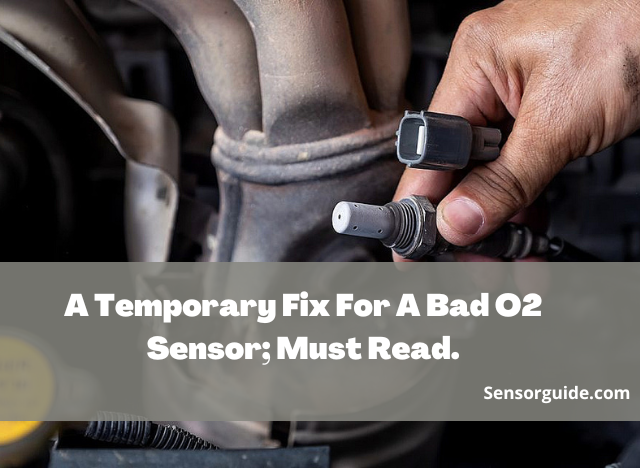How To Clean O2 Sensor? Step By Step Guide
The O2 or oxygen sensor is a vital component in your vehicle’s engine management system. Its primary function is to measure the oxygen levels in the exhaust gases, providing crucial feedback to the engine control unit (ECU) for adjusting the air-fuel mixture. The O2 sensor contributes to optimal engine performance, fuel efficiency, and reduced emissions by maintaining the correct air-fuel ratio.
Table of Contents
Signs of a Dirty O2 Sensor

Decreased fuel efficiency
A dirty O2 sensor can lead to decreased fuel efficiency due to inaccurate readings. When the sensor becomes coated with dirt or grime, it may provide incorrect data to the ECU, causing it to adjust the air-fuel mixture improperly. As a result, the engine may run rich, consuming more fuel than necessary.
Engine misfires and rough idling
Contaminated O2 sensors can disrupt the engine’s air-fuel ratio, leading to engine misfires and rough idling. The sensor’s inability to provide accurate readings can cause the ECU to deliver an incorrect amount of fuel, resulting in poor combustion and unstable engine operation.
Increased emissions
A dirty O2 sensor compromises the effectiveness of emission control systems. Inaccurate readings may prevent the ECU from adjusting the air-fuel mixture to optimal levels, leading to increased emissions of pollutants such as nitrogen oxides (NOx) and hydrocarbons (HC).
Check Engine Light (CEL) indication
A dirty or malfunctioning O2 sensor often triggers the Check Engine Light (CEL) on the vehicle’s dashboard. The CEL serves as a warning, indicating a potential issue with the O2 sensor or the engine’s overall performance. Ignoring the CEL can lead to further damage and increased emissions.
How to clean O2 sensor? Step by step guide
01. Preparing for the Cleaning Process
Gathering the necessary tools and materials
Before cleaning the O2 sensor, ensure you have the following tools and materials:
- Safety gloves
- Safety goggles
- O2 sensor cleaner or cleaning solution
- Wire brush or toothbrush
- Clean water for rinsing
- Compressed air for drying
- Anti-seize compound
Ensuring safety precautions
Safety is paramount when working with automotive components. Wear safety gloves and goggles to protect yourself from any potential hazards, such as chemicals in the cleaning solution or debris from the sensor.
Locating the O2 sensor in your vehicle
Refer to your vehicle’s manual or conduct an online search to locate the O2 sensor. In most vehicles, the sensor is found near the exhaust manifold or downpipe. Identifying its precise location will facilitate the cleaning process.
02. Removing the O2 Sensor
Disconnecting the electrical connection
Start by disconnecting the electrical connection of the O2 sensor. This is typically achieved by releasing the locking mechanism and gently pulling the connector apart. Exercise caution to avoid damaging the wiring or connector.
Using the appropriate tools to loosen the sensor
Once the electrical connection is detached, utilize the appropriate tools, such as a socket wrench or O2 sensor socket, to loosen the sensor. Apply steady and controlled force in a counterclockwise direction to release the sensor from the exhaust system.
Removing the sensor from the exhaust system
After loosening the sensor, carefully unscrew it by hand, ensuring not to drop or damage it. Slowly pull the sensor out of the exhaust system, taking note of its orientation for reinstallation.
03. Cleaning Methods for O2 Sensors
Using a specialized O2 sensor cleaner
Consider using a specialized O2 sensor cleaner available in automotive supply stores. These cleaners are specifically formulated to remove contaminants without damaging the sensor. Follow the product instructions for optimal results.
Soaking the sensor in a cleaning solution
Alternatively, you can create a cleaning solution by mixing a mild detergent or automotive cleaner with water. Soak the O2 sensor in the solution, ensuring that the sensor’s sensitive components are fully immersed. Allow it to soak for the recommended duration specified by the cleaning solution manufacturer.
Using a wire brush or toothbrush to remove debris
Remove any remaining dirt or debris after soaking, gently scrub the sensor with a wire brush or toothbrush. Be cautious not to scrub too vigorously, as excessive force can damage the sensor’s delicate components.
Using compressed air to blow away dirt and grime
Once the scrubbing is complete, rinse the sensor with clean water to remove any cleaning solution residue. Finally, use compressed air to blow away any remaining dirt or grime, ensuring the sensor is thoroughly dry before reinstallation.
04. Cleaning the O2 Sensor
Step-by-step instructions for cleaning
- Spray or soak the sensor in the cleaner solution: If using a specialized O2 sensor cleaner, follow the instructions provided. Otherwise, prepare a cleaning solution by mixing a mild detergent or automotive cleaner with water and soak the sensor as instructed.
- Gently scrub the sensor with a brush: After soaking, use a wire brush or toothbrush to scrub the sensor, removing accumulated dirt and grime softly. Take care not to apply excessive pressure to avoid damaging the sensor.
- Rinse the sensor with clean water: Thoroughly rinse the sensor with clean water to remove any cleaning solution residue, ensuring all traces of dirt are eliminated.
- Use compressed air to dry the sensor: Once rinsed, dry the sensor completely using compressed air. Ensure no moisture remains before proceeding to reinstall the sensor.
05. Reinstalling the O2 Sensor
A. Applying anti-seize compound to the sensor threads
Before reinstalling the O2 sensor, apply a thin layer of anti-seize compound to the sensor threads. This compound prevents the sensor from seizing or getting stuck during future removal, simplifying maintenance procedures.
B. Tightening the sensor properly
Carefully align the O2 sensor with the threading in the exhaust system and begin tightening it by hand. Once snug, use the appropriate tools to tighten the sensor further. Ensure not to overtighten, as this can damage the sensor or the exhaust system.
C. Reconnecting the electrical connection
Reconnect the electrical connection by aligning the connector and gently pushing them together until you hear a click or feel a secure connection. Double-check that the connection is properly seated to avoid electrical issues.
06. Testing and Verifying the O2 Sensor
A. Clearing the CEL codes
After cleaning and reinstalling the O2 sensor, clear any stored fault codes from the vehicle’s ECU using an OBD-II scanner. This step ensures that any previously triggered CEL codes are no longer present, allowing the ECU to accurately monitor the sensor’s performance.
B. Performing an O2 sensor test
To verify the O2 sensor’s functionality, you can perform an O2 sensor test using an automotive diagnostic tool or consult a professional mechanic. This test assesses the sensor’s responsiveness and accuracy, ensuring it operates within acceptable parameters.
C. Monitoring the sensor’s performance
After cleaning, monitoring the O2 sensor’s performance during regular vehicle operation is crucial. Pay attention to fuel efficiency, engine performance, and the absence of CEL indications. Any recurring issues may require further inspection or potential replacement of the sensor.
How to clean the O2 sensor with brake cleaner?
Cleaning an O2 sensor with brake cleaner is a simple process. Start by removing the sensor from the exhaust system.
- Spray the sensor with brake cleaner, making sure to cover all surfaces. Allow the cleaner to penetrate and dissolve any dirt or grime for a few minutes.
- Next, gently scrub the sensor using a soft brush or toothbrush, removing any remaining debris. Rinse the sensor with clean water to remove any cleaner residue.
- Finally, use compressed air to thoroughly dry the sensor before reinstalling it. Cleaning the O2 sensor with brake cleaner helps restore its functionality and ensures optimal vehicle performance.
Cleaning O2 sensor with vinegar; Step By Step guide
Cleaning an O2 sensor with vinegar is a straightforward process. Here’s a step-by-step guide:
- Start by removing the O2 sensor from the exhaust system. Refer to the vehicle’s manual or search online to locate and disconnect the sensor from the electrical connection.
- Prepare a cleaning solution by mixing white vinegar and water equal parts in a container. Ensure there is enough solution to submerge the sensor fully.
- Place the O2 sensor in the container, ensuring it is fully immersed in the vinegar solution. Let it soak for approximately 30 minutes to allow the vinegar to dissolve any built-up deposits.
- After soaking, use a soft brush or toothbrush to gently scrub the sensor, particularly around the sensing element and the wiring connector. This helps to remove any remaining dirt or debris.
- Once scrubbed, rinse the O2 sensor with clean water to remove any vinegar residue.
- After rinsing, use compressed air to dry the sensor thoroughly. Ensure that all moisture is removed to prevent potential damage or inaccurate readings.
- Reinstall the O2 sensor back into the exhaust system, making sure to tighten it securely. Reconnect the electrical connection.
Cleaning an O2 sensor with vinegar can help remove contaminants and restore its performance. However, it’s important to note that vinegar is acidic and may not be suitable for all types of O2 sensors. Therefore, it is recommended to consult the vehicle’s manual or seek advice from a professional if you are unsure about using vinegar for cleaning your specific O2 sensor.
What is the fastest way to clean an O2 sensor?
Fastest Way to Clean an O2 Sensor:
- Remove the O2 sensor from the exhaust: Locate the O2 sensor on your vehicle’s exhaust system. You may need a specialized O2 sensor socket or wrench to remove it.
- Spray the sensor with sensor-safe cleaner: Use a sensor-safe cleaner or solvent that is specifically designed for cleaning O2 sensors. Apply the cleaner to the sensor’s tip and any exposed parts.
- Allow it to air dry: Let the sensor air dry completely before reinstalling it. Avoid using compressed air or heat to speed up the drying process, as this can damage the sensor.
- Reinstall the sensor: Carefully reinstall the O2 sensor back into the exhaust system.
How to clean oxygen sensor without removing it?
It is possible to clean an oxygen sensor without removing it, but it is not always effective. If the sensor is heavily fouled, it may need to be removed and cleaned in a more specialized way.
Here are the steps on how to clean an oxygen sensor without removing it:
- Locate the oxygen sensor. It is usually located in the exhaust manifold or the exhaust pipe.
- Apply a chemical cleaner to the sensor. There are a number of commercial chemical cleaners that can be used for this purpose.
- Allow the cleaner to soak for a period of time. The instructions on the cleaner will typically specify how long it needs to soak.
- Rinse the sensor with water. Be sure to rinse away all of the cleaner.
- Start the engine and let it run for a few minutes. This will help to burn off any remaining cleaner.
It is important to note that cleaning an oxygen sensor without removing it is not always effective. If the sensor is heavily fouled, it may need to be removed and cleaned in a more specialized way.
Cleaning O2 sensor with MAF cleaner; Is it possible?
Yes, you can clean an O2 sensor with MAF cleaner. MAF cleaner is a type of chemical cleaner that is specifically designed to clean mass airflow sensors. However, it can also be used to clean oxygen sensors.
Here are the steps on how to clean an oxygen sensor with MAF cleaner:
- Locate the oxygen sensor. It is usually located in the exhaust manifold or the exhaust pipe.
- Disconnect the electrical connector from the sensor.
- Spray the MAF cleaner onto the sensor. Be sure to spray all sides of the sensor.
- Allow the cleaner to soak for a period of time. The instructions on the cleaner will typically specify how long it needs to soak.
- Rinse the sensor with water. Be sure to rinse away all of the cleaner.
- Reconnect the electrical connector to the sensor.
- Start the engine and let it run for a few minutes. This will help to burn off any remaining cleaner.
It is important to note that cleaning an oxygen sensor with MAF cleaner is not always effective. If the sensor is heavily fouled, it may need to be removed and cleaned in a more specialized way.
Conclusion
Maintaining a clean and properly functioning O2 sensor is crucial for optimal vehicle performance, fuel efficiency, and reduced emissions. Regularly cleaning and monitoring the sensor contributes to the longevity and reliability of your vehicle’s engine.
In summary, the cleaning process for an O2 sensor involves preparing for the task, removing the sensor, selecting and executing appropriate cleaning methods, and reinstalling the sensor correctly.
By addressing the signs of a dirty O2 sensor and following the cleaning procedures outlined in this article, you can restore the sensor’s performance, enhance fuel efficiency, and minimize harmful emissions. Regular maintenance and attention to your O2 sensor ensure your vehicle operates at its best, providing a smooth and efficient driving experience.





